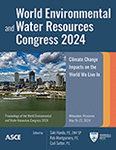Evaluating the Performance of Sequence-to-Sequence LSTM Model in Streamflow Modeling under the Beas River, India
Publication: World Environmental and Water Resources Congress 2024
ABSTRACT
Accurate streamflow forecasting is crucial for effectively managing the water related disasters. However, there exist several challenges as the data exhibit multitude of nonlinearity. For this endeavor, various physics based and machine-learning approaches have been investigated with the aim to improve the accuracy. Recently, deep learning techniques such as long short-term memory (LSTM) and sequence-to-sequence (seq2seq) have proven to yield better results capturing the nonlinear time series patterns. This paper focused on exploring the potential of LSTM-seq2seq model for the streamflow forecasting. To demonstrate the proposed method, the data such as daily rainfall, average temperatures streamflow from Beas River watershed, located in the Indian Himalayan region were used. The model performance was found to be good having the Nash-Sutcliffe efficiency of 0.98, correlation coefficient of 0.86, Kling-Gupta Efficiency of 0.88, and mean absolute error of 79.65 cumecs.
Get full access to this chapter
View all available purchase options and get full access to this chapter.
REFERENCES
Adeloye, A. J., Soundharajan, B. S., Ojha, C. S. P., and Remesan, R. (2016). Effect of hedging-integrated rule curves on the performance of the pong reservoir (India) during scenario-neutral climate change perturbations. Water Resources Management, 30(2), 445–470. https://doi.org/10.1007/s11269-015-1171-z.
Hafi, A. (1995). This document is discoverable and free to researchers across the globe due to the work of AgEcon Search. Help ensure our sustainability. facto rs Influencing Price of Agricultural Products and Stability Counte. AgEcon Search, 18.
Beven, K. (1989). Changing ideas in hydrology - The case of physically-based models. Journal of Hydrology, 105(1–2). https://doi.org/10.1016/0022-1694(89)90101-7.
Beven, K. J., and Kirkby, M. J. (1979). A physically based, variable contributing area model of basin hydrology. Hydrological Sciences Bulletin, 24(1). https://doi.org/10.1080/02626667909491834.
Castellarin, A., et al. (2013). Prediction of flow duration curves in ungauged basins. In Runoff Prediction in Ungauged Basins. https://doi.org/10.1017/cbo9781139235761.010.
Faudzi, A. A. M., Raslan, M. M., and Alias, N. E. (2023). IoT based real-time monitoring system of rainfall and water level for flood prediction using LSTM Network. IOP Conference Series: Earth and Environmental Science, 1143(1). https://doi.org/10.1088/1755-1315/1143/1/012015.
Gers, F. A., Schmidhuber, J., and Cummins, F. (2000). Learning to forget: Continual prediction with LSTM. Neural Computation, 12(10), 2451–2471. https://doi.org/10.1162/089976600300015015.
Gupta, H. V., Sorooshian, S., and Yapo, P. O. (1999). Status of Automatic Calibration for Hydrologic Models: Comparison with Multilevel Expert Calibration. Journal of Hydrologic Engineering, 4(2), 135–143. https://doi.org/10.1061/(asce)1084-0699(1999)4:2(135).
Hochreiter, S., and Schmidhuber, J. (1997). Long Short Term Memory. Neural Computation. Neural Computation, 9(8), 1735–1780.
Iverson, B. L., and Dervan, P. B. (n.d.). No 主観的健康感を中心とした在宅高齢者における 健康関連指標に関する共分散構造分析Title. 7823–7830.
Lecun, Y., Bengio, Y., and Hinton, G. (2015). Deep learning. Nature, 521(7553), 436–444. https://doi.org/10.1038/nature14539.
Milly, P. C. D., Betancourt, J., Falkenmark, M., Hirsch, R. M., Kundzewicz, Z. W., Lettenmaier, D. P., and Stouffer, R. J. (2008). Climate change: Stationarity is dead: Whither water management? In Science (Vol. 319, Issue 5863). https://doi.org/10.1126/science.1151915.
Nash, J. E., and Sutcliffe, J. V. (1970). River flow forecasting through conceptual models part I - A discussion of principles. Journal of Hydrology, 10(3). https://doi.org/10.1016/0022-1694(70)90255-6.
Ncube, S., Beevers, L., Adeloye, A. J., and Visser, A. (2018). Assessment of freshwater ecosystem services in the Beas River Basin, Himalayas region, India. Proceedings of the International Association of Hydrological Sciences, 379, 67–72. https://doi.org/10.5194/piahs-379-67-2018.
Rasheed, Z., Aravamudan, A., Gorji Sefidmazgi, A., Anagnostopoulos, G. C., and Nikolopoulos, E. I. (2022). Advancing flood warning procedures in ungauged basins with machine learning. Journal of Hydrology, 609. https://doi.org/10.1016/j.jhydrol.2022.127736.
Van Houdt, G., Mosquera, C., and Nápoles, G. (2020). A review on the long short-term memory model. Artificial Intelligence Review, 53(8), 5929–5955. https://doi.org/10.1007/s10462-020-09838-1.
Zamani, M. G., Nikoo, M. R., Rastad, D., and Nematollahi, B. (2023). A comparative study of data-driven models for runoff, sediment, and nitrate forecasting. Journal of Environmental Management, 341. https://doi.org/10.1016/j.jenvman.2023.118006.
Information & Authors
Information
Published In
History
Published online: May 16, 2024
ASCE Technical Topics:
- Business management
- Continuum mechanics
- Developing countries
- Engineering fundamentals
- Engineering mechanics
- Errors (statistics)
- Flow (fluid dynamics)
- Fluid dynamics
- Fluid mechanics
- Forecasting
- Hydraulic engineering
- Hydrologic engineering
- Mathematics
- Model accuracy
- Models (by type)
- Practice and Profession
- River engineering
- Rivers and streams
- Statistics
- Streamflow
- Water and water resources
- Water management
Authors
Metrics & Citations
Metrics
Citations
Download citation
If you have the appropriate software installed, you can download article citation data to the citation manager of your choice. Simply select your manager software from the list below and click Download.
